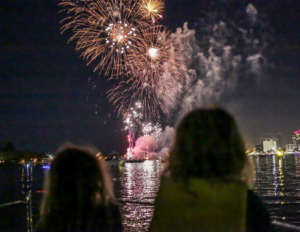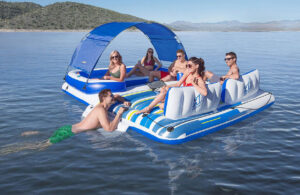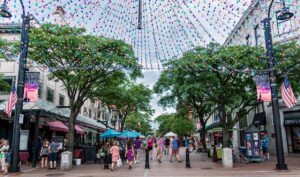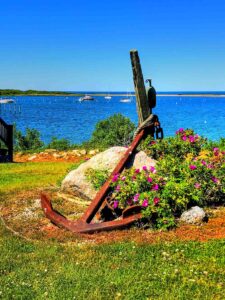Tourists aren’t always kind to Mother Nature, but when you visit these Florida eco-tourism destinations, you can explore nature in its prime.
They come to her spectacular places eager to be awed but often leave behind trails of trash, squander her resources and snag mementos that should be left undisturbed. 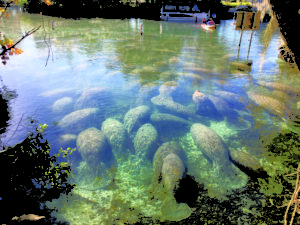
Fortunately, conservationists are educating, building awareness and changing behavior toward our delicate planet, and Florida is at the epicenter of this eco-friendly shift. With 1,350 miles of coastline, the Sunshine State is spearheading efforts to protect waterways and shores, while cultivating eco-tourism destinations that delight visitors who appreciate the state’s natural wonders and care about preserving them for future generations.
Stewards of Florida eco-tourism’s 160 state parks and protected lands invite you to take a tour or explore on your own these remarkable locations:
Flagler Beaches & the Palm Coast
This 19-mile stretch of Atlantic beaches presents a haven for sunbathers, boaters and anglers seeking a pristine, undeveloped coastline. Cruising by boat, canoe or kayak leads to natural habitats of turtles and other aquatic creatures, as well as sanctuaries for 200+ waterfowl species such as osprey and blue heron. Its 125 miles of hiking and biking trails provide scenic paths through ancient oaks and indigenous vegetation. North Peninsula State Park, Bulow Creek State Park and the Graham Swamp Conservation Area are key places to visit.
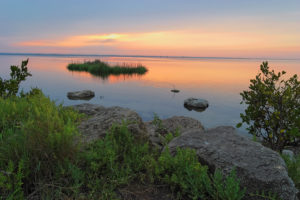
Canaveral National Seashore
Ecotourists at this 58,000-acre barrier island park enjoy unforgettable adventures from the sand to the sky. Its beaches offer ideal vantage points for rocket launches from Kennedy Space Center, and Night Sky Exploration Programs investigate the planets and stars. Earth-bound explorers can travel along 24 miles of beach, sand dunes and habitats for threatened or endangered species, including loggerhead sea turtles, bald eagles, manatees, right whales and wood storks. Mosquito Lagoon harbors clams, oysters, crabs and shrimp.
Everglades National Park
At mainland Florida’s southern tip awaits the largest subtropical wilderness in North America and one of the few places where crocodiles and alligators coexist. Traveling through these 1.5 million acres of wetlands by tour boat or kayak introduces you to manatees, dolphins, reptiles and other fantastic creatures. Most of the park is accessible only by water, but you can still find plenty of places for hiking, biking, bird watching and camping. The best time to visit is December through May when low waters make animals more visible and mosquitos are less bothersome.
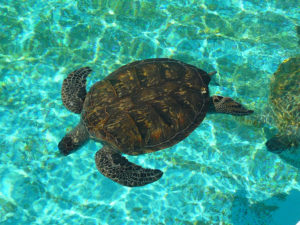
Florida Keys
For decades, the Keys have strived to achieve balance between bolstering tourism and protecting a plethora of natural resources. The result is a spectacular eco-friendly haven packed with activities that attract guests from around the globe. The world’s third largest barrier reef encircles the Keys and creates a sanctuary for 6,000+ aquatic plants and creatures. Divers and snorkelers become swim buddies with marine turtles, manatees, exotic fish and colorful coral. Bottlenose dolphins flourish in the warm waters and welcome you at conservation facilities such as the Dolphin Research Center in Marathon. The long list of other must-see eco-attractions includes John Pennekamp Coral Reef State Park, Key West Tropical Forest & Botanical Gardens, Audubon House, National Key Deer Refuge, Florida Keys National Marine Sanctuary, Marathon Wild Bird Center, Florida Keys Eco-Discovery Center, Butterfly Conservatory & Nature Museum and the Botanical Gardens at Kona Kai Resort.
Corkscrew Swamp Sanctuary
For more than 100 years, National Audubon Society has fought to make sure developers and farmers did not drain this swamp. About a half hour east of Naples, the 13,000 acres of everglades is a nesting and breeding ground for birds ranging from snowy egrets to storks and songbirds. Rare plants, such as the Ghost Orchid, live here next to alligators, tortoises, black bears and fox squirrels. Hiking the 2.2-mile boardwalk takes you through a wet prairie, marshland and into the largest old growth bald cypress forest in North America. Stop by the visitor and discovery center for a film detailing the park’s history, educational and art exhibits, children’s activities, and a café for snacks and refreshments.
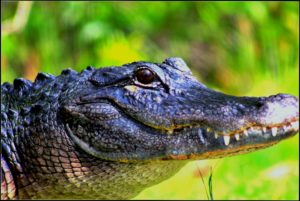
Punta Gorda
The charming town of Punta Gorda is nestled in Gasparilla Sound, and it’s an idyllic home base for eco-explorers seeking unique Florida habitats. Several seaside nature parks are a quick boat ride away, including the Cape Haze Aquatic Preserve, which has calm waters and a network of irresistible islands, and Charlotte Harbor Preserve State Park, where 80% of the coastline is protected. This beautiful estuary is a prime location for bird watching, hiking, kayaking, fishing and observing a menagerie of aquatic and land animals. Nearby the Randell Research Center’s 67-acres of coastal land present the history of the Calusa Indians, along with programs on the region’s ecology. A short jaunt east lies Babcock Ranch with guided ecotours of a swamp and habitats that harbor alligators, wild hogs, turkeys, deer and more.
Ellie Schiller Homosassa Springs Wildlife State Park
In the early 1900s, train passengers left their comfy seats, eased into Homosassa’s cool waters and enjoyed a picnic while freight cars were loaded with local wood, produce and seafood. A popular natural attraction for more than a century, this park protects wildlife ranging from endangered manatees and panthers to waterfowl and alligators. A partially covered boardwalk trail offers a close-up view of indigenous animals, while the Underwater Observatory gives a unique subterranean perspective of sealife and habitats. Exhibits of captive creatures that cannot live in the wild present hippos, red wolves, whooping cranes and black bears. Educational programs share the latest intel on regional ecosystems.
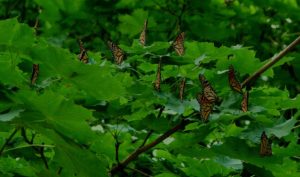
Crystal River Archaeological State Park
With all the eco-sites along Central Florida’s Gulf Coast, it’s easy to miss this hidden gem that’s tucked away behind scores of islands in Crystal Bay. Fed by nearly 50 freshwater springs, the wildlife refuge was established as a sanctuary for manatees. You can take guided tours or kayaks to meet these marvelous creatures that migrate by the hundreds here to hibernate in winter. Native American historical sites dating back more than 2,000 years attract today’s visitors who also enjoy hiking trails, scuba diving, kayaking, fishing, bird watching and other outdoor adventures.
Florida Caverns State Park
Need a break from the sun? Then head underground to explore the cool world of Florida’s caves. Guided flashlight tours take visitors on trails and passageways to spacious subterranean rooms carved by hand in the 1930s by the Civilian Conservation Corps. Stalagmites, stalactites and rocks transformed into magical shapes by relentless drops of water are sure to inspire young imaginations. The ranger station, visitor center, museum and picnic pavilion are open, but some biking, hiking, boating and camping areas are still under repair after Hurricane Michael.
Navarre Beach
It’s hard to imagine a trip to Florida without strolling along a white sand beach, and this one is certainly worth a visit. Navarre covers about 25 miles of pristine waterfront between Pensacola and Destin. Nature lovers can dip into its warm, gentle Gulf waters before going bird watching or exploring a prime example of a coastal dune ecosystem. About 14,000 annual visitors flock to the Panhandle Butterfly House to see scores of them up close and witness the yearly monarch butterfly migration to Mexico. But the area’s main eco-attraction is the Sea Turtle Conservation Center where environmentalists hope to safeguard turtle nesting areas, foster growth of hatchlings and bolster their odds for survival.
Cover photo courtesy of Discover Crystal River FL


